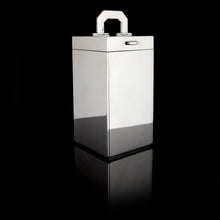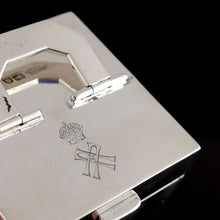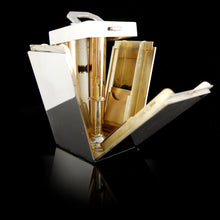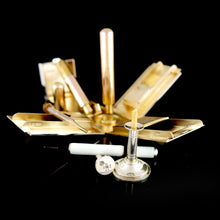Queen Alexandra’s Travelling Desk Set, 1911
Adding product to your cart
Height overall: 11cm (4.5in)
Provenance:
HM Queen Alexandra, Queen Mother (1844-1925)
Dorothy, Countess Haig, Maid of Honour to Queen Alexandra (1901-1905)
Silver and silver gilt. Travelling desk set contained in an upright rectangular case with push catch hinged lid, engraved with Queen Alexandra’s crowned double ‘A’ cypher and fitted with a hinged handle, the sides hinged to the base opening out to reveal a gilt interior with compartments for stamps, vestas and stationery, together with a match striker; the recessed base fitted with removable taper stick seated over a silver seal matrix engraved with the Queen Alexandra’s cypher, all held in position by three hinged fittings for tubular containers, one for a glass ink dropper (rubber perished), and the other for replacement tapers, and an Asprey’s patented ball-point pen. Maker’s mark of Asprey, Bond Street, London. Hallmarked London 1911.
Read more
The present compendium dates to the early days of Queen Alexandra’s widowhood. The death of Edward VII in 1910 was a bitter blow to the Queen who was reluctant to accept her diminished status. She hoped instead to enjoy a similar position to her sister, the dowager Empress of Russia, who enjoyed precedence at St Petersburg over the wife of the reigning sovereign. Taking the newly created title of Queen Mother, she was slow to vacate Buckingham Palace and return once more to Marlborough House. George V and Queen Mary tactfully acquiesced in several breaches of protocol such as continuing to fly the royal standard over Buckingham Palace and addressing her letters to her son to ‘King George’ rather than to ‘The king’.

The Hon Dorothy Vivian, later Countess Haig (1879-1939) was closely connected with Queen Alexandra over many years. In 1901 she was appointed one of four Maids of Honour - having served Queen Victoria in the role since 1899. During her tenure she fulfilled an historic custom connected with the Maids of Honour, which was that should one of these ladies marry during her term of office, she was to have a dowry from the Queen of ₤1000, with the proviso that th Queen’s consent should be given to the marriage. In Dorothy Vivian’s case the custom was fulfilled in duplicate when she and her fellow Maid of Honour Mary Hart Dyke became engaged to Douglas Haig and one Captain Bell. Moreover the two couples were married in a double weffing ceremony in the Private Chapel at Buckingham Palace on 11 July 1905.















